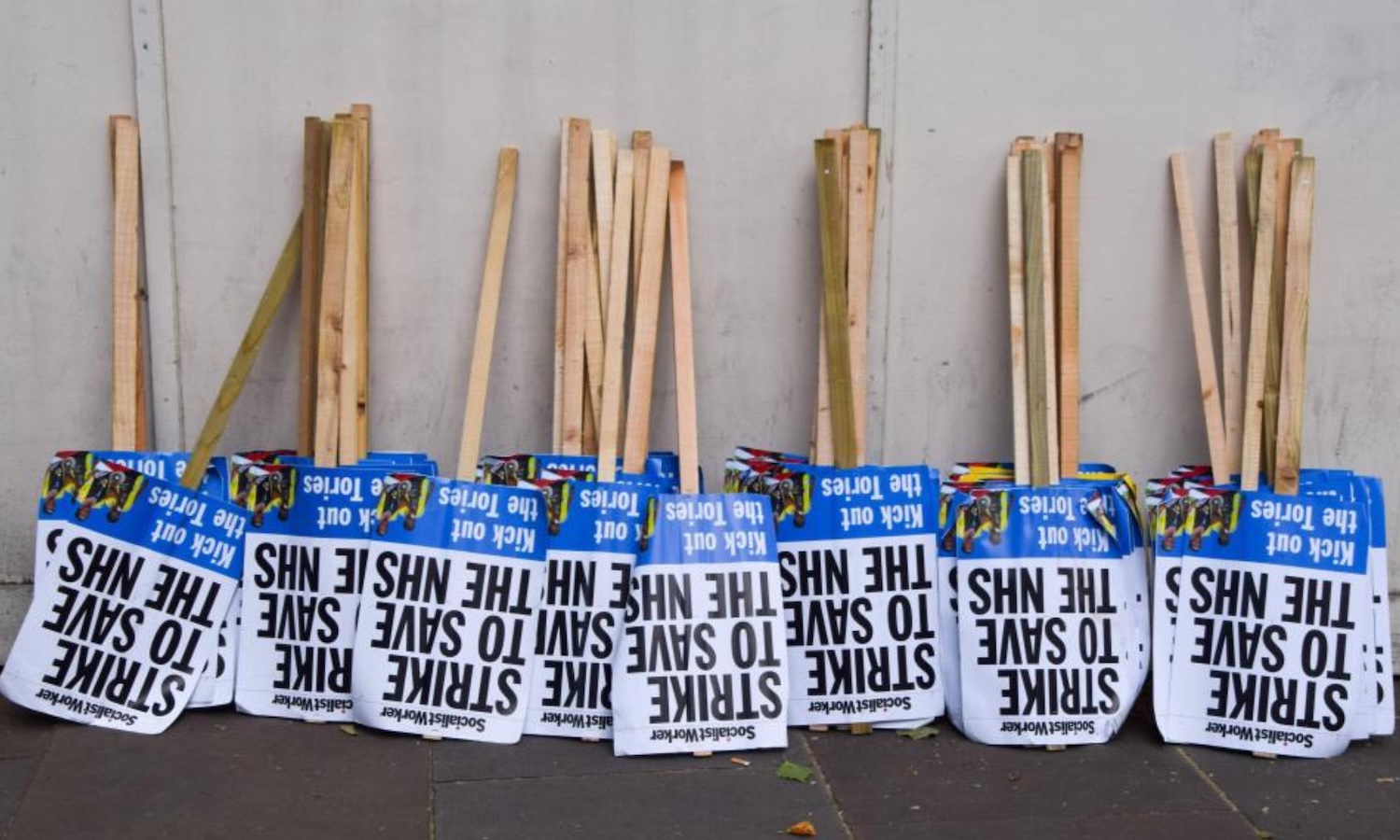‘Modern monetary theory’ (MMT) is one of the latest fads being offered as an easy solution to the fundamental problems of capitalism, pushed by the ‘left’ wing of the Democratic party in the US and the Corbynistas in Britain. It presents an apparently easy weapon with which to slay conservative opponents who pester them with the question: where is the money to come from with which to pay for your spending proposals?
In MMT, which someone has wittily described as the ‘magic money tree’, its proponents claim to have discovered the means of funding everything on their shopping list without raising taxes or bothering about such trifles as class struggle.
To those who assert that the ‘left’s’ demands, such as a publicly-funded national health service, free education, affordable council housing, massive investment in green energy, etc, are unrealistic and unaffordable, MMT offers the ‘solution’ through the simple medium of printing money.
MMT can hardly be characterised as a theory, let alone a modern one. It is in fact merely a rehash of the failed prescriptions of Keynesianism.
The followers of MMT are best captured in the following memorable words of Keynes himself – the defunct economist whose theory they are dishing out to the unwary and gullible as if it were a brand new panacea:
“Practical men who believe themselves to be quite exempt from any intellectual influence are usually the slaves of some defunct economist. Madmen in authority, who hear voices in the air, are distilling their frenzy from some academic scribbler of a few years back.”
Ever since the worst crisis of capitalism (2007-08) hit, the capitalist world has been stuck in a state of “secular stagnation”, to use the apt terminology of Larry Summers, US treasury secretary under Bill Clinton and subsequently an advisor to Barack Obama, while the working class has been subjected to austerity and cuts. This has been a period of stalling growth and subdued investment.
Not surprisingly, then, not only the working class, but even respectable bourgeois economists, often those of the Keynesian variety, are calling into question the demand for austerity and balanced budgets and the neoliberal consensus that has held sway over the past three decades.
Powerful forces are gearing up against the priesthood that regards the ‘invisible hand’ of the market as inviolable. And this priesthood is fighting back by attacking and lobbing insults at anyone daring to propose alternatives to the market-fundamentalist consensus that swept all before it following the collapse of the erstwhile USSR and other socialist countries.
With austerity failing and interest rates hitting negative territory, what other tools have the bourgeois governments available in their toolkits? The global capitalist economy has been kept in business with never-ending injections of cheap credit and gargantuan government stimuli.
Bourgeois economic thinkers are at their wits’ end, as the Nobel laureate economist Paul Krugman frankly admitted during a speech in the aftermath of the 2008 crisis. Speaking to an audience at the London School of Economics (LSE), he said: “Most work in macroeconomics in the past 30 years has been useless at best and harmful at worst.” (Dismal science, The Economist, 11 June 2009)
What is MMT?
There are numerous versions of this eclectic theory, whose devotees attempt to hoodwink their opponents through contortions and mental gymnastics, distorting economic ideas and confusing the reader.
In the words of the Economist: “Speaking with MMT’s adherents is something like watching a football match with friends who insist the ball remains stationary while every other element in the game, including the pitch and goalposts, move around it.” (Is modern monetary theory nutty or essential?, 14 May 2019)
Briefly, MMT asserts that:
1. Governments that issue their own sovereign, ‘independent’ currency will never be short of money because they can elect to pay any debts by resorting to the creation of any amount of money.
2. This will not create inflation provided such governments spend money with reckless abandon and run budget deficits, as long as the economy has spare productive capacity.
3. Instead of raising taxes to fund public expenditure, governments spend first and then adjust taxes so as to manage demand in the economy.
Not surprisingly, MMT has attracted considerable support from the petty-bourgeois ‘left’ for what it implies: namely, that there is no need for governments to be bothered about balancing the books, since they can always access money to pay the bills.
The problem with the advocates of MMT lies in their total inability to understand either the nature of money or the role it performs in a capitalist economy. They believe that money is a creation of the government, deriving its value from its status as legal tender (this theory of money is known as ‘chartalism’); that the state creates money and generates a demand for this currency by insisting on its use as a medium of payment.
The truth, however, is that money is not introduced by consent or agreement; it comes into use spontaneously, as a product of social development. It is “the highest product of the development of exchange”. (VI Lenin, Karl Marx, Chapter III: ‘Marx’s economic doctrine’, 1914)
Money plays a most important part in the transition from small-scale commodity production to capitalism. Capital first originates in the form of money.
Money is a universal equivalent – the embodiment of value, the embodiment of abstract labour. It is the stamp with which the market puts its label of social recognition onto commodities, transforming them from products of private labour into products of social labour.
The functions of money
As Karl Marx explained, money has a number of functions in a commodity economy. A commodity is sold for a definite sum of money; this sum is called the price of the commodity. This price is value expressed in money terms. In this role, money operates as a measure of value.
To be a measure of value, money had itself to be a commodity and possess value. Money does not have to be present to serve as a measure of value; it fulfils this function as ideal money.
After a commodity has been priced, it must be sold – ie, exchanged for money. This exchange is called the circulation of commodities, which is inseparably linked up with the circulation of money itself. Here, money functions as a medium of circulation, or the means of commodity turnover.
To fulfil the role of the means of circulation, money must be actually present, but it does not need to possess a value of its own. As such, full value money – gold – can be replaced in this function by substitutes or symbols of itself – eg, paper currency, silver or copper coins. These substitutes for gold have either no value at all, or much less than the value that they represent.
The law of value is the law of motion of capitalist commodity production.
The amount of money necessary in circulation at a given moment depends on the sum total of prices of all commodities in circulation; the sum total of the prices in return depends on the quantity of commodities in circulation and the price of each individual commodity.
In addition, the amount of money needed, for example in the course of a year, depends upon the rapidity of the currency of money. If circulation takes less time, less money is needed for the process of circulation, and vice versa.
As a store of wealth (value) money facilitates the maintenance and preservation of accumulated wealth.
As a means of payment money is used in settlement of debts or payment of taxes.
Money, to repeat, is the product of the development of commodity production and exchange. As Marx stressed, money is a social relation, resulting from a lengthy process of development of commodity production and exchange, leading in the end to the development of capitalism, with all the contradictions inherent in commodity production – exacerbated to the nth degree.
Above all, money is the universal equivalent; it is the embodiment of value, the embodiment of abstract labour. Money, says Marx, is the “universal representative of material wealth”. (Capital, 1867, Chapter 3)
“Being the highest product of the development of exchange and of commodity production, money masks and hides the social character of individual labour, the social tie between the various producers whom the market brings together.” (Lenin, op cit)
The proponents of MMT do not even attempt, let alone provide, an analysis of commodity production and exchange. Not surprisingly, then, the essence of capitalism, and the role money plays in it, entirely eludes them.
MMT’s advocates assert that the state can create money. That is correct, with certain provisos. What it cannot do is to ensure that this money has any value, for without the backing of a productive economy, money has no significance.
Real value is created in production, through the application of socially-necessary labour time, with money being a representative of the value so created. The money created by the state, therefore, will be of any worth only to the extent that it is a reflection of the values in circulation in the economy.
If the state floods the market in such a way that money exceeds the sum of prices of all the commodities in circulation, it can only serve to act as a recipe for inflation and economic instability.
Further, the devotees of MMT incorrectly assert that the state creates the demand for money. Under the conditions of capitalism, the overwhelming bulk of money in circulation – more than 95 percent of all money in the economy – is created by private banks, through bank deposits and loans, not by governments.
This money is created to meet the demand from consumers and investors in the form of credit and loans. If shrinking consumer consumption or business investment (or both) dries up this demand, so must the demand for money dwindle alongside it.
The state can create money, but it cannot guarantee that this money is used. The massive programmes of quantitative easing practiced by the imperialist countries following the 2008 crisis of capitalism bear eloquent testimony to this.
Despite Gargantuan amounts of money injected into the economy by the central banks since 2008, business investment and GDP growth have, to put it mildly, remained subdued. Instead of investment into productive capacity, vast amounts have gone into the stock market, with the speculators reaping a bonanza whilst working people struggle to make a living.
Thus it is clear that it is the needs of capitalist production that create the demand for money. Capitalist production is driven solely by profit; capitalists will not produce anything unless they can make a profit. But since the proponents of MMT have practically nothing to say about profit – the motive force of the capitalist system – they are at a loss to explain the real dynamics of the capitalist economy.
One of the assertions of MMT advocates is that governments that have run their own ‘independent’ fiat currency cannot go insolvent.
True, a government in a country like the USA, where the central bank can increase money supply, can always choose to turn to the printing presses to discharge its debt obligations and finance its budget deficit.
However, there is hardly a government in the world apart from the US, with its currency the dollar, which can be characterised as genuinely ‘independent’ and sovereign. Excluded from this category are the members of the Eurozone, whose financial policies are subject to the European Central Bank. Excluded, too, are most of the oppressed countries of Asia, Africa and Latin America, many of whom are indebted to the imperialist powers and whose debts are denominated in the US currency.
Even for a country like Britain, where the Bank of England can set interest rates, print money and make loans to the government in its own currency, independence is a chimera. Even if a ‘left’ Labour government were to come to office with a large-scale agenda of nationalisation and public programmes paid for through deficit financing and a loose monetary policy, the result could only be that it lost the confidence of the markets.
The financiers would move their money out of the country, capital would go on strike; there would be roaring inflation and the currency would be rendered worthless. This in turn would force the government to spike interest rates to rein in inflation and attract investment.
This scenario is no figment of the imagination. Just take two examples:
Harold Wilson won the 1974 election at a time when the global capitalist economy was being buffeted by a crisis, marked by stagflation (a mixture of slump and inflation) consequent upon several decades of the application of Keynesianism. Wilson was forced out of office owing to popular opposition to his calls for austerity and cuts in expenditure.
He was succeeded by James Callaghan. Fearful of a run on the pound, the new prime minister was obliged humiliatingly to turn to the IMF with a request for a $3.9bn bailout – the largest loan the IMF had ever been asked for at the time.
As is known to everyone, IMF loans come with conditions attached. Labour had fought, and won, the 1974 election on a promise of nationalising Britain’s top 25 monopolies. Now it found itself in the role of an instrument of the IMF, pushing through austerity measures.
Contrary to popular perception, it was not Margaret Thatcher who pronounced the end of the Keynesian consensus. It was the Labour prime minister James Callaghan who did so in the following words: “The cosy world we are told would go on for ever, where full employment would be guaranteed by the stroke of the chancellor’s pen, cutting taxes, deficit spending, that cosy world is gone.” (1976)
At the end of the day, the same could happen in the US. The dollar’s dominance – its role as a world currency – is reliant on the strength and stability of US capitalism and its status as the dominant imperialist power, lording it over the rest of the capitalist world. If the strength of the US economy came to be questioned by the markets, the dollar’s hegemony could quickly collapse.
Even the Economist was obliged to observe recently that “the dollar’s dominance is not guaranteed to last indefinitely”. (Many governments could bear more debt. That does not mean they should, 16 May 2019)
After all, this has happened before when, in the early 1930s, “the pound sterling lost its pre-eminence”. Britain, with a debt-to-GDP ratio in excess of 150 percent, faced a currency crisis at the time. There is little reason to believe that the same fate will not fall to US capitalism and the dollar.
Our second example: François Mitterrand’s government in France was elected in 1981 on a Keynesian programme, promising a rise in the minimum wage, a 39-hour week and large-scale nationalisations. Within two years of his coming to office, capital flight and a decline in the competitiveness of French industry forced Mitterrand to make a U-turn and resort to austerity.
Monetary independence within capitalism is an illusion. Only by breaking out of the shackles of capitalism – through proletarian revolution, the establishment of the dictatorship of the proletariat and the building of a planned socialist economy – can the needs of the masses be met.
To achieve this it is not the money supply that needs to be increased: what needs to be done as a matter of urgency is to take the message to the masses of proletarians that the only way to get out of the mess in which we find ourselves is to put an end to the capitalist system of production, which is long past its sell-by date and which continues to inflict so much misery on hundreds of millions of people throughout the world through unemployment, destitution, homelessness, poverty, hunger and devastating wars.
This is something that the MMT advocates shun like the devil shuns holy water. The fairy tales propagated by them of printing our way to socialism are just that – fairy tales.
Capitalism and crisis
Just like its predecessor Keynesianism, MMT essentially avoids grappling with the question of production under capitalism and the laws governing it. Just like Keynesianism, the MMT analysis, if one may apply that term to such quackery, utterly fails to deal with relations between society’s two irreconcilably hostile classes – the bourgeoisie and the proletariat.
It fails to deal with the fundamental contradiction of capitalist society: that between the productive forces, which are social, and the relations of production, which produces recurrent crises of overproduction.
In the words of Lenin: “Gigantic crashes have become possible and inevitable, only because powerful social productive forces have become subordinated to a gang of rich men, whose only concern is to make profits.” (The lessons of the crisis, August 1901)
In the race for profits, capitalism has a tendency towards an unlimited expansion of production. But this tendency meets the immoveable barriers of capitalist relations. These barriers have their roots in the fact that the consumption capacity of the broad masses is limited because of their exploitation by capital.
From its earliest days, capitalism has been characterised by crises of overproduction. This is how Friedrich Engels described the process of development of capitalist economy from one crisis to the next:
“Since 1825, when the first general crisis broke out, the whole industrial and commercial world, the production and exchange of all civilised peoples and their more or less barbarian dependent peoples have been dislocated practically once in every ten years.
“Trade comes to a standstill, the markets are glutted, the products lie in great masses, unsaleable, ready money disappears, credit vanishes, the factories are idle, the working masses go short of food because they have produced too much food, bankruptcy follows upon bankruptcy, forced sale upon forced sale.
“The stagnation lasts for years, both productive forces and products are squandered and destroyed on a large scale, until the accumulated masses of commodities are at last disposed of at a more or less considerable depreciation, until production and exchange gradually begin to move again.
“By degrees the pace quickens; it becomes a trot; the industrial trop passes into a gallop, and the gallop in turn passes into the mad onrush of a complete industrial, commercial, credit and speculative steeplechase, only to land again in the end, after the most breakneck jumps – in the ditch of a crash, and so on, again and again …
“In these crises, the contradiction between social production and capitalist appropriation comes to a violent explosion. The circulation of commodities is for the moment reduced to nothing; the means of circulation, money, becomes an obstacle to circulation; all the laws of commodity production and commodity circulation are turned upside down.
“The economic collision has reached its culminating point: the mode of production rebels against the mode of exchange.” (F Engels, Anti-Dühring, 1877, Chapter 24)
During a crisis of overproduction, the “whole mechanism of the capitalist mode of production breaks down under the pressure of the productive forces which it [capitalism] itself created. It is no longer able to transform this mass of means of production into capital; they lie idle and for this very reason the industrial reserve army must also lie idle.
“Means of production, means of subsistence, available labourers, all the elements of production and of general wealth are there in abundance but ‘abundance becomes a source of distress of want’ (Fourier) because it is precisely abundance that prevents the conversion of the means of production and subsistence into capital.
“For in capitalist society the means of production cannot function unless they have first been converted into capital, into means for the exploitation of human labour power. The necessity for the means of production and subsistence to take the form of capital stands like a ghost between them and the workers.
“It alone prevents the coming together of the material and personal levers of production; it alone forbids the means of production to function, the workers to work and to live.
“Thus on the one hand, the capitalist mode of production stands convicted of its own incapacity any longer to control these productive forces and, on the other hand, these productive forces themselves press forward with increasing force to put an end to the contradiction, to rid themselves of their character as capital, to the actual recognition of their character as social productive forces.” (Ibid)
And lastly, during these capitalist crises: “There breaks out an epidemic that, in all earlier epochs, would have seemed an absurdity – the epidemic of overproduction. Suddenly society finds itself put back into a state of momentary barbarism; it appears as if a famine, a universal war of devastation had cut off the supply of every means of subsistence; industry and commerce seem to be destroyed.
“And why? Because there is too much civilisation, too much means of subsistence, too much industry, too much commerce. The productive forces at the disposal of society no longer tend to further the development of bourgeois property; on the contrary, they have become too powerful for these conditions, by which they are fettered, and so soon as they overcome these fetters they bring disorder into the whole of bourgeois society, endanger the existence of bourgeois society.
“The conditions of bourgeois society are too narrow to comprise the wealth created by them. And how does the bourgeoisie get over these crises? On the one hand, enforced destruction of a mass of productive forces; on the other, by the conquest of new markets and by the more thorough exploitation of the old ones.
“That is to say, by paving the way for more extensive and destructive crises and by diminishing the means whereby crises are prevented.” (K Marx and F Engels, The Communist Manifesto, 1848, Chapter 1)
The MMTers have absolutely nothing to say on the conditions of production that prevail under capitalism and the inevitable result of these conditions – crises of overproduction.
MMT refers to the state as though it were some kind of benign neutral institution standing above classes. Every serious student of the subject knows that every state is an instrument in the hands of the ruling class for the subjection, by force of arms if necessary, of the class ruled.
In the conditions of capitalism, as Marx and Engels so vividly put it: “the executive of the modern state is nothing but a committee for managing the common affairs of the whole bourgeoisie”. (Ibid)
Those who sincerely desire to have in place a government that will work in the interests of the masses must work to establish a proletarian state. One would look in vain in MMT for even a hint of the need to smash the bourgeois state, or of the role of the working class in bringing about such an outcome, and replacing it with a proletarian state that will look after the common affairs of the working people.
The leading lights and camp followers of MMT want to bring about ‘transformational policies’ without in the least challenging the power of the capitalist class; without getting rid of capitalist economic relations. For them, as for any ordinary bourgeois radical, private property, and with it the anarchy of the market, are sacred, sacrosanct and inviolable.
To calm their right-wing critics, Richard Murphy, a leading MMTer, assures them that MMT supporters have “no plans to sweep the private sector aside”. Instead of the proletariat “seizing the means of production”, Bill Mitchell, another MMTer, asserts: “it is the working class seizing the means of production of money”.
The historical role of the working class, far from being that of seizing the means of production of money, is to do away with commodity production, and with it money, altogether.
Just like Keynesians, the MMT proponents are working overtime to save capitalism and patch it up, instead of getting rid of this historically outmoded system. MMT’s emphasis is on ‘demand management’ and is modelled on President Franklin D Roosevelt’s New Deal, with its emphasis on public works aimed at stimulating US economic growth during the Great Depression – very much on Keynesian lines.
Every informed person knows that the New Deal was a failure. Despite it, unemployment and under-employment in the US kept up its upward incline. Only with the start of the second world war and the recruitment of vast numbers of workers into the armed forces and the armaments industry did unemployment begin to fall. Even then it took several years after the end of the war before unemployment came down to levels tolerable even under capitalism, which cannot exist without having a reserve army of labour.
Keynes himself was obliged to admit as much, saying: “It is, it seems, politically impossible in a capitalist democracy to organise expenditure on a scale necessary to make the grand experiments which would prove my case – except in war conditions.” There can hardly be any doubt that a New Deal today would fare no better, be it in the US, Britain or elsewhere. (Quoted in CLR James, Reconversion-1, New International, March 1945)
Everywhere in the world, the crisis of overproduction is all too evident. Markets are saturated with products from steel and cars to smartphones. Industrial enterprises lie idle while millions of workers are subjected to unemployment, underemployment and zero-hour contracts.
If the advocates of MMT are ever questioned about the underutilisation of industrial capacity and the ever-present reserve army of labour, and why it is that businesses are not investing, they merely state that this is because of a ‘lack of effective demand’. In his day, Keynes replied to this question by saying that capitalists were driven by ‘business confidence’.
This invocation to capitalism’s animal spirits is not science but sorcery, for confidence has a material basis – namely, the profitability of production. If capitalists can smell a profit, they will be full of confidence and eager to invest and produce. If not, pessimism and despondency will set in, with a resultant slump.
The prospect of a large enough profit arouses not only the animal spirits but also the predatory and criminal spirits of the bourgeoisie. In the pursuit of such a profit there is not a crime that the capitalist will not commit:
“If money, according to Augier, ‘comes into the world with a congenital bloodstain on one cheek’, capital comes dripping from head to foot, from every pore, with blood and dirt,” wrote Karl Marx in Capital, adding a footnote that revealed the bloodthirsty nature of capitalism:
“Capital is said a by a Quarterly Reviewer to fly turbulence and strife, and to be timid, which is very true; but this is very incompletely stating the question. Capital eschews no profit, or very small profit, just as nature was formerly said to abhor a vacuum.
“With adequate profit, capital is very bold. A certain 10 percent will ensure its full employment anywhere; 20 percent certain will produce eagerness; 50 percent positive audacity; 100 percent will make it ready to trample on all human laws; 300 percent and there is not a crime at which it will scruple, nor a risk it will not run, even to the chance of its owner being hanged.
“If turbulence and strife will bring a profit, it will freely encourage both. Smuggling and the slave trade have amply proved all that is here stated.” (T J Dunning, quoted by K Marx, Capital, 1867, Chapter 31)
Because of the basic contradiction of capitalism – that between social production and private appropriation; the contradiction between the productive forces and the relations of production – the working class cannot afford to buy the products they produce because of the extraction of surplus value by the capitalists. As a result, capitalism’s ability to produce far outstrips the ability of the market to absorb its products.
Doubtless, capitalism can temporarily overcome these limits through investment of the surplus into new means of production and by resorting to credit to expand the market. But these palliatives merely pave the way for “more extensive and more destructive crises in the future”. (Communist Manifesto, op cit)
The crash of 2008 was witness to the culmination of such a process – an outcome that had been postponed for decades through the application of Keynesian policies and the exponential growth of credit alike. Now that the crisis is upon us, neither the followers of Keynes nor those of MMT can explain why. Marxism alone offers an explanation for the crisis, as well as the way out of it.
The votaries of MMT don’t show any inclination to gain a scientific insight into the economy. Instead, they delude themselves with the belief that the government can dictate to the market, failing to understand that the laws of the market are far stronger than any government or the legislation enacted by bourgeois parliaments. Under capitalism, it is the market and its laws that dictate to governments.
Thus it can be seen that MMT is not only wrong but also harmful, for it sows illusions among working people, making way for disappointment, disillusionment and cynicism.
Only Marxism offers the way out of the mess we are in. The proletariat will achieve its liberation through a scientific analysis of the economy. To paraphrase Marx: those who would change the world must first understand it.
It is a shame to have to repeat these truths a whole 150 years after Marx so clearly formulated them. But, sadly, the working-class movement has suffered so heavily from all the ravages of opportunism that we have to restate these basic truths.















